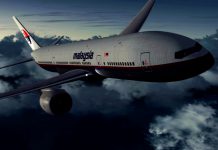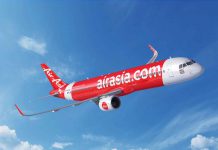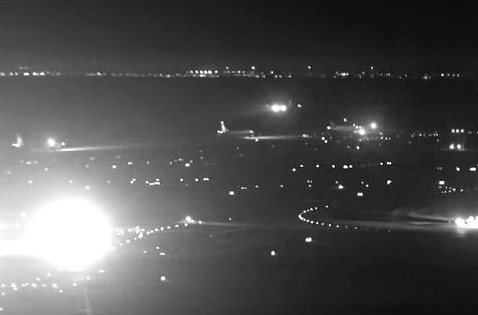A flight arriving about four minutes before an Air Canada A320 swooped on on a crowded San Francisco International Airport taxiway reported being hampered by bright construction lights.
Four aircraft — an Airbus A340, two Boeing 787s and a Boeing 737 — were on the taxiway awaiting takeoff clearance on July 7, 2017, when the crew of Air Canada Flight 759 mistook if for a runway.
After flying over the first aircraft on the taxiway, the plane dropped as low 59 feet above ground level — barely above the 56ft height of a Boeing 787 tail — before it began to gain height.
WATCH: Reach for the sick bag!
The aircraft performed a go-around and returned to land safely but experts have said it could have been one of the worst catastrophes in aviation history.
This dramatic video of the event, which should be expanded to full screen, accompanied the release of more than 30 factual documents Wednesday by the US National Transportation Safety Board. The documents did not include any conclusions about the factors leading to the incident.
The Airbus A320 was arriving from Toronto with 135 passengers and five crew on board and the experienced pilots had been told to land on runway 28R. Instead, they lined up on parallel taxiway C.
Runway 28L was closed for construction at the time and the crew of an aircraft landing four minutes before the Air Canada flight reported that constructions lights were so bright they could not determine the 28L’s location.
The NTSB said the crew members of the earlier aircraft reported questioning if they were lined up with runway 28R but determined this was the case after checking lateral navigation equipment.
“They received additional confirmation about 300 feet above ground level when the captain visually acquired the painted “28R” on the paved surface of the runway,” the NTSB said.
“The captain of that flight further reported that the aircraft on taxiway C were stopped and had their taxi lights off, which ‘helped to create this misconception that taxiway C was runway 28R.”
NTSB documents show that both Air Canada pilots said they began feeling fatigued during the flight to San Francisco.
The documents show the flight had been flown by autopilot until just before the final waypoint on the approach.
At this point, the captain disconnected the autopilot and hand flew the remainder of the approach. He asked the first officer to verify the runway was clear.
READ our ratings for Air Canada.
A transcript of air traffic control voice recordings has the first officer querying lights on the runway and asking for confirmation the plane is cleared to land.
A controller replies: “Air Canada seven five nine confirmed cleared to land runway two eight right. There’s no one on runway two eight right but you. ‘
Seconds later a United Airline pilot asks: “Where ’s this guy going. He’s on the taxiway.’’
Shortly afterward, air traffic control tells the pilots to go around.
The first officer told investigators his attention was initially more inside the cockpit than out because he needed to look at a chart to set the missed approach altitude and heading.
When the captain asked him to query the control tower, he looked outside and “it didn’t look right”.
“Although he was not certain what was incorrect, he was unable to process what he was seeing, he subsequently commanded the go around to the captain by saying ‘go around go around’,” the NTSB said.
“According to the captain, that was simultaneous to him beginning the go around. During the initiation of the go around, the ATCT controller also issued go around instructions.”
























